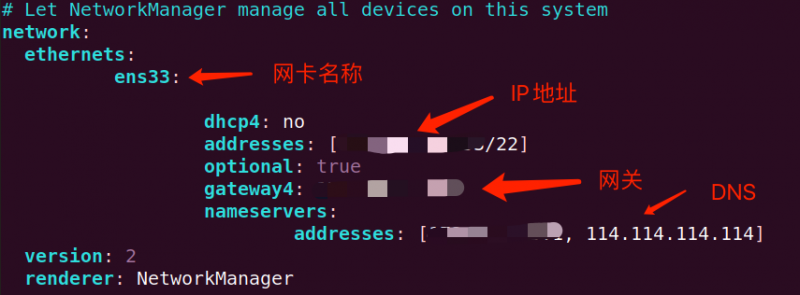ansible笔记

最近学了ansible视频几节课,全部跟着操作了一遍。操作一遍就能记熟了吗?
不! 不能! 所以,需要将笔记保存下来,以备后查。
############### Ansible中文权威指南 http://www.ansible.com.cn/ ######### 一般实验环境
# 192.168.52.6
# 192.168.52.7
# 192.168.52.8
# 192.168.52.9
wget https://mirrors.aliyun.com/epel/7/x86_64/Packages/e/epel-release-7-12.noarch.rpm
rpm -Uvh epel-release-7-12.noarch.rpm
yuminfo ansible
yuminstall -y ansible
rpm -ql ansible |less
file /usr/bin/ansible
# /etc/ansible/ansible.cfg 主配置文件(几乎不必修改)
# /etc/ansible/hosts 主机列表(管理对象)
# /etc/ansible/roles 角色
# hosts文件示例:
[vm]
192.168.52.[7:9]
#cent7[b:d]
[appsvrs]
192.168.52.7
192.168.52.8
[dbsvrs]
192.168.52.9
192.168.52.7
上面是基本信息,下面是一些基本命令
# sshansible all
-m ping -k # all 则操作hosts中所有主机#
-u 指定用户名,无此参数则默认当前用户#
-k 需要密码认# 可以使用SSH认证后不必再用
-kssh-keygenssh-copy-id192.168.52.7
ssh-copy-id192.168.52.8
ssh-copy-id192.168.52.9
ansible all -m ping
ansible-doc -s ping # 获取ping 模块简要帮助
ansible-doc -F |grep zabbix
ansible all --list # 列出所有主机
ansible dbsvrs --list # 列出所有主机
常见模块使用
## ping 模块ansible
192.168.* -m ping # 操作hosts中所有192.168开头主机ansible appsvrs:dbsvrs
-m ping # oransible
"appsvrs:&dbsvrs" -m ping # and## command 模块
ansible
-doc commandansible all
-a "df -h"ansible all
-a "ls /opt"ansible all
-a "removes=/opt/1.txt cat /opt/1.txt" # 不存在则不执行ansible dbservers
-a "removes=/data/mariadb ls -l /data"ansible all
-a "creates=/opt/1.txt cat /opt/1.txt" # 存在则不执行ansible dbservers
-a "creates=/data/mariadb ls -l /data"ansible all
-a "chdir=/home ls"## shell 模块
ansible all
-m shell -a "echo $HOSTNAME"# 例:关闭selinux
ansible all
-a "ls -l /etc/selinux/"ansible all
-m copy -a "src=/root/config dest=/etc/selinux/config backup=yes" # 本机文件到远程ansible all
-a "cat /etc/selinux/config"ansible all
-m shell -a "rm -f /etc/selinux/config.*" # 删除备份ansible all
-m shell -a "reboot"ansible all
-m shell -a "last reboot"ansible all
-a "getenforce"ansible all
-m shell -a "useradd mongodb"ansible all
-m shell -a "passwd mongodb"## script 模块
ansible all
-m script -a "/root/h.sh"## copy 复制当前目录某文件到远程
ansible all
-m copy -a "src=./h.sh dest=/root/ mode=000 owner=mongodb"ansible all
-a "ls -l /root/"ansible all
-a "cat /root/h.sh"# 直接向远程目录写文件
ansible all
-m copy -a "content="#!/bin/bashntpdate cn.pool.ntp.org" dest=/root/f2.sh mode=644 owner=mongodb
"ansible all
-a "cat /root/f2.sh"## fetch 抓取远程文件
ansible all
-m shell -a "tar Jcf /tmp/log.tar.xz /var/log/*.log"ansible all
-m fetch -a "src=/tmp/log.tar.xz dest=/opt"yuminstall -y tree
tree /opt
tar tvf /opt/192.168.52.7/tmp/log.tar.xz
## file 模块
ansible all -m file -a "state=directory mkdir /test" # 创建目录
ansible all -m file -a "name=/test/tmp state=directory"
ansible all -m file -a "name=/tt/tmp/123 state=directory"
ansible all -m file -a "path=/test/f3 state=touch" # 创建空文件
ansible all -m file -a "name=/test/f3 state=absent" # 删除文件
ansible all -m file -a "name=/tt/ state=absent" # 删除目录(包括子目录和文件)
ansible all -m file -a "src=/etc/passwd dest=/test/pwd.lmk state=link" # 创建软链接
ansible all -a "ls -l /test"
## hostname 模块
ansible 192.168.52.7 -m hostname -a "name=cent7b"
## cron 模块
ansible all -m cron -a "minute=* weekday=1,3,5 job="/usr/bin/wall FBI warning" name=warn" # new
ansible all -m cron -a "disabled=true job="/usr/bin/wall FBI warning" name=warn" # disabled
ansible all -m cron -a "disabled=yes job="/usr/bin/wall FBI warning" name=warn" # disabled
ansible all -m cron -a "disabled=Y job="/usr/bin/wall FBI warning" name=warn" # disabled
ansible all -m cron -a "disabled=no job="/usr/bin/wall FBI warning" name=warn" # enabled
ansible all -m cron -a "disabled=false job="/usr/bin/wall FBI warning" name=warn" # enabled
ansible all -m cron -a "state=absent job="/usr/bin/wall FBI warning" name=warn" # delete
## yum 模块
ansible all -m yum -a "name=tree state=latest"
ansible all -m yum -a "name=tree,vim,ntp state=present" # 安装
ansible all -m yum -a "name=tree state=absent" # 删除
ansible all -m shell -a "rpm -q tree"
ansible all -m copy -a "src=/root/samba-4.8.3-6.el7_6.x86_64.rpm dest=/root/" # rpm 安装
ansible all -m yum -a "name=/root/samba-4.8.3-6.el7_6.x86_64.rpm disable_gpg_check=Y"
ansible all -m yum -a "name=lsof update_cache=yes" # 同时更新缓存
ansible all -m yum -a "name=dstat update_cache=yes" # dstat 是监控工具
## service 模块
ansible-doc -s service
ansible all -m service -a "name=zabbix-server state=stopped" # reloaded, restarted, started
ansible all -m service -a "name=mysqld state=restarted"
ansible all -m service -a "name=zabbix-server enabled=no"
ansible all -a "systemctl is-enabled zabbix-server"
## user 模块
ansible appsvrs -m user -a "name=nginx shell=/sbin/nologin system=yes home=/home/nginx groups=root,bin uid=80 comment="nginx service""
ansible all -a "getent passwd nginx"
ansible appsvrs -m user -a "name=nginx state=absent remove=yes"
ansible appsvrs -m group -a "name=nginx system=yes gid=80" # 创建组
ansible appsvrs -m group -a "name=nginx state=absent" # 删除组
ansible all -a "getent group nginx"
galaxy 类似于脚本库,可以下载现成的脚本作为参考 控制台则是ansible的交互界面
## ------------------------------- galaxy ------------------------------ansible
-galaxy install geerlingguy.nginxansible
-galaxy list geerlingguy.nginxansible
-galaxy listcd .ansible
/roles/cp geerlingguy.nginx/ my.nginx -rp # 创建副本
ansible-galaxy list
ansible-galaxy remove geerlingguy.nginx/ # 或者直接删除 roles/下的目录
ansible-console # 控制台
# root@appsvrs(2)[f:5] # 用户@组(数量)[请求数:5]
cd 192.168.52.8 # 切换主机
user name=test1 state=absent remove=yes # 删除远程用户
YAML 语法 Yet Another Markup Language
#### YAML语法:# 单一文件中,连续三个字符(---)区分多个档案,而三个点(...)则表示档案结尾
# 次行开始写playbook内容,一般建议写功能
# 使用 # 号注释
# 缩进必须统一,不能空格与Tab混用
# 缩进级别必须一致,程序判定配置的级别是根据缩进和换行来实现
# 严格区分大小写
# k/v 的值可同行也可换行,同行使用冒号分隔(: )
# v 可以是字符串,也可以是另一个列表
# 一个完整的代码块最少需要包括 name 和 task
# 一个 name 只能包括一个 task
# YAML 扩展名为 yml 或 yaml
## List 列表,所有元素以 - 开头
---
# 一个美味水果的列表
- Apple
- Orange
- Strawberry
- Mango
## Dictionary 字典,通常用 k/v 组成
---
# 一位职工的记录
name: Elly
job: Developer
skill: Elite
playbook
## ------------------------------- playbook ----------------------------# hello.yml
---- hosts: appsvrs
remote_user: root
tasks:
- name: hello
command: hostname
ansible-playbook hello.yml # 执行 hello.yml# ansible
-vault encrypt hello.yml # 加密文件# ansible
-vault decrypt hello.yml # 解密文件# ansible
-vault view hello.yml # 查看# ansible
-vault edit hello.yml # 编辑# ansible
-vault rekey hello.yml # 换密码# ansible
-vault create h.yml # 直接创建加密的文件ansible
-playbook hello.yml --ask-vault-pass # 直接运行加密文件
playbook 操作文件示例
# file.yml
---- hosts: dbservers
remote_user: root
tasks:
- name: create new file
file: name=/data/newfile state=touch
- name: new user
user: name=test2 system=yes shell=/sbin/nologin
- name: install tree
yum: name=tree
- name: copy config
copy: src=/root/hello.yml dest=/data/
- name: copy test html
copy: src=files/test.html dest=/data/
- name: start service
service: name=squid state=restarted enabled=yes
ansible-playbook --syntax-check file.yml # not executeansible
-playbook -C file.yml # checkansible
-playbook file.yml # run# src文件内容更新后,再次执行playbook,会覆盖旧文件
ansible
-playbook file.yml --list-hosts # 列出主机ansible
-playbook file.yml --list-tasks # 列出任务ansible
-playbook file.yml --limit 192.168.52.8 # 限制执行ansible
-playbook file3.yml --ask-vault-pass # 涉及加密文件# file3.yml
---- hosts: dbservers
remote_user: root
become: yes # 改变用户
become_user: mongodb # 变成谁
become_method: sudo # playbook 时需要 -K
tasks:
- name: create new file
file: name=/data/newfile5 state=touch
- name: cp files
copy: src=file.yml dest=/data/
- name: cp test html
copy: src=files/test.html dest=/data
ansible-playbook file3.yml -K # become_user 密码
playbook 中使用Handlers 与 notify ,以及 tags
## Handlers 与 notify # act1.yml
---- hosts: vm
remote_user: root
tasks:
- name: install httpd pkg
yum: name=httpd
tags: insthttpd
- name: copy conf file
copy: src=httpd.conf dest=/etc/httpd/conf/ backup=yes
notify:
- restart httpd
- chk httpd process
- name: start service
service: name=httpd state=started enabled=yes
tags: starthttpd
handlers:
- name: restart httpd
service: name=httpd state=restarted
- name: chk httpd process
shell: killall -0 httpd > /tmp/httpd.log # yum install psmisc
# 执行指定的 tags 步骤ansible
-playbook -t insthttpd,starthttpd act1.yml# tags可以同名,则相同tags的动作都会被执行
ansible
-playbook act2.yml -t httpd
playbook 中使用变量
#------------------------- 模块 setup 用来收集主机的系统信息ansible vm
-m setup -a "filter=ansible_hostname"ansible vm
-m setup -a "filter=ansible_fqdn"ansible vm
-m setup -a "filter=*ipv4*"#
------------------------- 变量 ---------------------------------------# 可以命令行,playbook, role ,
/etc/ansible/hosts 中定义##
1. app.yml # 执行时传入变量
---- hosts: vm
remote_user: root
tasks:
- name: install pkg
yum: name={{ pkname }}
- name: start service
service: name={{ pkname }} state=started enabled=yes
ansible-playbook -e "pkname=vsftpd" app.yml # 传入ansible
-playbook -e "pkname1=httpd pkname2=memcached" app2.yml # 多个# ansible vm
-m shell -a "rpm -q httpd memcached "# ansible vm
-m yum -a "name=httpd,memcached state=absent"##
2. playbook 中定义并使用变量 app3.yml
---- hosts: vm
remote_user: root
vars:
- pkname1: httpd
- pkname2: vsftpd
tasks:
- name: install pkg
yum: name={{ pkname1 }}
- name: install pkg2
yum: name={{ pkname2 }}
ansible-playbook app3.yml # 无需再传入变量##
3. hosts文件中定义变量
[vm]192.168.52.5 http_port=8181 # 普通变量
192.168.52.6 http_port=8080
192.168.52.7
[vm:vars] # 公共变量
nodename=www
domainame=bbc.com
http_port=80
# app4.yml
---- hosts: vm
remote_user: root
tasks:
- name: set hostname
hostname: name={{nodename}}{{http_port}}.{{domainame}}
# 变量优先级指定: 命令行 > 配置文件, 普通 > 公共ansible
-playbook -e "nodename=web" app4.yml # 指定变量值ansible vm
-a "hostname"
#
4. 使用系统变量 (如 setup 模块中的) testvars.yml
---- hosts: vm
remote_user: root
tasks:
- name: create log file
file: name=/data/{{ ansible_fqdn }}.log state=touch mode=600 owner=nginx
ansible-playbook testvars.yml # ansible_fqdn 为系统变量
#
5. 使用专门的变量文件# vars.yml
var1: httpdvar2: vsftpd
# testvars2.yml---- hosts: vm
remote_user: root
vars_files:
- vars.yml
tasks:
- name: install pkg
yum: name={{ var1 }}
- name: create files
file: name=/data/{{ var2 }}.log state=touch
ansible-playbook testvars2.ymlansible vm
-m shell -a "rpm -q httpd"ansible vm
-a "ls /data/"# ansible 管理容量在300台左右,再多,性能跟不上
# gather_facts: false
模板的使用
#------------------------- Jinja2 template ----------------------------## template 模块只能用于playbook
ansible
-doc templatemkdir templatecp /etc/nginx/nginx.conf template/nginx.conf.j2ansible vm
-m setup |grep cpu # 得到 ansible_processor_vcpus# 修改模板文件 nginx.conf.j2 修改cpu和端口为变量
user nginx;worker_processes {{ ansible_processor_vcpus
// 2 }};...
listen {{ http_port }} default_server;
listen [::]:{{http_port }} default_server;
...
# 修改脚本 testemp.yml
---- hosts: vm
remote_user: root
tasks:
- name: install nginx
yum : name=nginx
- name: copy template
template: src=nginx.conf.j2 dest=/etc/nginx/nginx.conf
notify: restart nginx
- name: start service
service: name=nginx state=started enabled=yes
handlers:
- name: restart nginx
service: name=nginx state=restarted
ansible-playbook testemp.yml # 运行并验证ansible vm
-a "netstat -nltp"ansible vm
-m shell -a "ps -aux |grep nginx"ansible vm
-a "cat /etc/nginx/nginx.conf"
tasks 中使用 when
# 在 tasks 中使用 when ------------------------------------------------# 参考 https:
//www.cnblogs.com/nb-blog/p/10565658.htmlansible vm -m setup -a "filter=ansible_distribution" # CentOS
ansible vm -m setup -a "filter=ansible_distribution_major_version" # 7
# 再次修改 testemp.yml
---- hosts: vm
remote_user: root
tasks:
- name: install nginx
yum : name=nginx
- name: copy template for centos 7
template: src=nginx.conf7.j2 dest=/etc/nginx/nginx.conf
when:
- ansible_distribution == "CentOS"
- ansible_distribution_major_version == "7"
notify: restart nginx
- name: copy template for centos 6
template: src=nginx.conf6.j2 dest=/etc/nginx/nginx.conf
when: ansible_distribution_major_version == "6"
notify: restart nginx
- name: start service
service: name=nginx state=started enabled=yes
handlers:
- name: restart nginx
service: name=nginx state=restarted
ansible-playbook testemp.yml # 执行并验证 注意 skipping 信息ansible vm
-a "cat /etc/nginx/nginx.conf"ansible vm
-m shell -a "ps -aux |grep nginx"
tasks 中使用 with_items 列表,以及 嵌套子变量
# 迭代 with_items 用法 testitem.yml --------------------------------------
- hosts: vm
remote_user: root
tasks:
- name: create some files
file: name=/data/{{ item }} state=touch
with_items:
- f1.txt
- f2.txt
- f3.txt
- name: install some pkg
yum:
name: ["htop", "sl", "hping3"]
# 使用嵌套子变量 testitem2.yml ----------------------------------------
---
- hosts: vm
remote_user: root
tasks:
- name: create groups
group: name={{ item }}
with_items:
- g1
- g2
- g3
- name: create users
user: name={{ item.name }} group={{ item.gp }}
with_items:
- { name: "user1", gp: "g1" }
- { name: "user2", gp: "g2" }
- { name: "user3", gp: "g3" }
ansible-playbook testitem2.yml # 执行并验证
ansible vm -a "cat /etc/group"
ansible vm -a "cat /etc/passwd"
使用 for 循环 , if 条件
### for 循环 testfor.yml ------------------------------------------------ hosts: vm
remote_user: root
vars:
ports:
- 81
- 82
- 83
tasks:
- name: copy conf
template: src=for1.conf.j2 dest=/data/for1.conf
# templates/for1.conf.j2
{% for p in ports %}server{
listen {{ p }}
}
{
% endfor %}ansible-playbook testfor.yml # 执行并验证ansible vm
-a "cat /data/for1.conf"###
for 循环 结合变量字典 testfor2.yml -------------------------------
---- hosts: vm
remote_user: root
vars:
apps:
- web1:
port: 81
name: app1
dir: /data/web1
- web2:
port: 82
name: app2
dir: /data/web2
- web3:
port: 83
name: app3
dir: /data/web3
tasks:
- name: copy conf
template: src=for2.conf.j2 dest=/data/for2.conf
# templates/for2.conf.j2
{% for p in apps %}server{
listen {{ p.port }}
servername {{ p.name }}
documentroot {{ p.dir }}
}
{
% endfor %}ansible-playbook testfor2.yml # 执行并验证ansible vm
-a "cat /data/for2.conf"## 使用
if 判断 testif.yml --------------------------------------------
---- hosts: vm
remote_user: root
vars:
apps:
- web1:
port: 81
#name: app1
dir: /data/web1
- web2:
port: 82
name: app2
dir: /data/web2
- web3:
port: 83
#name: app3
dir: /data/web3
tasks:
- name: copy conf
template: src=if.conf.j2 dest=/data/if.conf
# if.conf.j2
{% for p in apps %}server{
listen {{ p.port }}
{
% if p.name is defined %} servername {{ p.name }}
{
% endif %} documentroot {{ p.dir }}
}
{
% endfor %}ansible-playbook testif.yml # 执行并验证ansible vm
-a "cat /data/if.conf"
### 插播一些 centos 有趣的命令: ---------------------------------------
cal # 当前月 cal -3 三个月
sl # 跑火车 -F -l -a
linux_logo # -L list
echo "dog" |boxes -d dog # yum install boxes
curl http://wttr.in # 天气
#---------------------------------- end --------------------------------
roles
### roles 用于层次性,结构化地组织 playbook --------------------------# 能够根据层次型结构自动装载变量文件、tasks以及handlers等。
# 在playbook中使用include指令。
# 用于复杂场景,代码复用度高。
# 一般用于基于主机构建服务场景,也可用于构建守护进程场景中。
mkdir roles/{httpd,mysql,memcached,nginx} -pv# ansible vm
-m shell -a "userdel -r nginx"cd nginx
mkdir tasks templates# 以nginx 为例,tree 结构如下:
├── nginx_roles.yml
└── roles
├── httpd
├── memcached
├── mysql
└── nginx
├── tasks
│ ├── group.yml
│ ├── main.yml
│ ├── restart.yml
│ ├── start.yml
│ ├── temp.yml
│ ├── user.yml
│ └──
yum.yml└── templates
└── nginx.conf.j2
# group.yml - name: create group
group: name=nginx gid=80
# user.yml
- name: create user
user: name=nginx uid=80 group=nginx system=yes shell=/sbin/nologin
# yum.yml
- name: install nginx
yum: name=ngin
# temp.yml
- name: copy conf
template: src=nginx.conf.j2 dest=/etc/nginx/nginx.conf
# start.yml
- name: start nginx
service: name=nginx state=started enabled=yes
# main.yml
- include: group.yml
- include: user.yml
- include: yum.yml
- include: temp.yml
- include: start.yml
# nginx_roles.yml
---
- hosts: vm
remote_user: root
roles:
- role: nginx
ansible-playbook nginx_roles.yml # 执行并验证ansible vm
-a "cat /etc/nginx/nginx.conf"ansible vm
-a "ps -aux |grep nginx"# 以apache为例
--------------------------------------------------ansible vm
-m shell -a "yum remove -y httpd"ansible vm
-m user -a "name=apache state=absent remove=yes"# tree
├── httpd_role.yml
└── roles
└── httpd
├── files
│ └── httpd.conf
├── tasks
│ ├── cpfile.yml
│ ├── main.yml
│ ├──
yum.yml│ ├── start.yml
│ └── user.yml
└── templates
# main.yml- include: user.yml
- include: yum.yml
- include: cpfile.yml
- include: start.yml
# httpd_role.yml
---
- hosts: vm
remote_user: root
roles:
- httpd
ansible-playbook httpd_role.yml # 执行并验证
调用 多个 role 或跨项目调用 role
# some_roles.yml 调用多个 role -------------------------------------
- hosts: vm
remote_user: root
roles:
- httpd
- nginx
# main.yml 跨项目调用别的role中任务
- include: roles/nginx/tasks/temp.yml
# temp.yml # 注意文件内容中使用绝对路径
- name: copy conf
template: src=/root/roles/nginx/templates/nginx.conf.j2 dest=/etc/nginx/nginx.conf
# tags when ---------------------------------------------
---
- hosts: vm
remote_user: root
roles:
- { role: httpd, tags: ["web","httpd"] }
- { role: nginx, tags: ["web","nginx"], when: ansible_distribution_major_version == "7" }
- { role: app, tags: "app" }
ansible-playbook -t web some_roles.yml
来一个综合练习
### 综合练习 app -------------------------------------------------------cd
/root/roles/appmkdir tasks templates vars handlers files
# group.yml- name: create group
group: name=app system=yes gid=123
# user.yml
- name: crt user
user: name=app system=yes shell=/sbin/nologin uid=123
# yum.yml
- name: install pkg
yum: name=httpd
# template httpd.conf.j2 包含:
Listen {{ ansible_processor_vcpus * 10 }}
User {{ username }}
Group {{ groupname }}
# vars/main.yml
username: app
groupname: app
# copy.yml
- name: copy conf
copy: src=vhost.conf dest=/etc/httpd/conf.d/
# tmpl.yml
- name: copy conf
template: src=httpd.conf.j2 dest=/etc/httpd/conf/httpd.conf
notify: restart httpd
# start.yml
- name: start httpd
service: name=httpd state=started enabled=yes
# handlers/main.yml
- name: restart httpd
service: name=httpd state=restarted
# httpd_role.yml
---
- hosts: vm
remote_user: root
roles:
- app
# tree├── httpd_role.yml
├── roles
│ ├── app
│ │ ├── files
│ │ │ └── vhost.conf
│ │ ├── handlers
│ │ │ └── main.yml
│ │ ├── tasks
│ │ │ ├── copy.yml
│ │ │ ├── group.yml
│ │ │ ├── main.yml
│ │ │ ├── start.yml
│ │ │ ├── tmpl.yml
│ │ │ ├── user.yml
│ │ │ └──
yum.yml├── templates
│ └── httpd.conf.j2
└── vars
└── main.yml
# 执行并验证:
ansible
-playbook httpd_role.ymlansible vm
-m shell -a "head /etc/httpd/conf/httpd.conf"ansible vm
-m shell -a "netstat -nltp"ansible vm
-m shell -a "ps -aux |grep httpd"
练习 :memcached
# memcached 安装: 根据内存大小更改配置文件 ----------------------------# templates
/memcached.j2
PORT="11211"USER
="memcached"MAXCONN
="1024"CACHESIZE
="{{ ansible_memtotal_mb // 4 }}"OPTIONS
=""
# tasks/yum.yml- name: install memcached
yum: name=memcached
# start.yml
- name: start memcached
service: name=memcached state=started enabled=yes
# tmpl.yml
- name: copy conf
template: src=memcached.j2 dest=/etc/sysconfig/memcached
# main.yml
- include: yum.yml
- include: tmpl.yml
- include: start.yml
# memcached_role.yml
---
- hosts: vm
remote_user: root
roles:
- memcached
# 执行并验证:ansible
-playbook memcached_role.ymlansible vm
-m shell -a "cat /etc/sysconfig/memcached"
以上是 ansible笔记 的全部内容, 来源链接: utcz.com/z/514228.html






